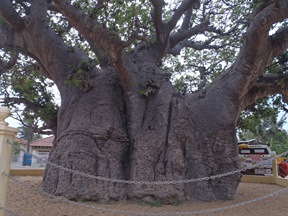Jaffna and the far north Thurs. 25 August – Friday 2 September 2011
We'd heard horror stories about the A9 road up to Jaffna -but compared to some we'd seen it was pretty good. The landscape was lush and green with lots of palm trees and red roads a bit like parts of the NT we both thought. The town of Vavuniya is the start point of what feels like the real north - the Vanni land which had once been the centre of the LTTE (Tamil Tigers) area of control. It seemed quite a mixed population having Hindu temples, churches and a really striking mosque in the middle of town. Just north of the town is the military check point. Once travelling up to this region must have been a nightmare of stop/starting through numerous SLA (Sri Lankan army) and then Tiger check points (the Tigers even had an immigration stamp apparently for when you entered their territory) but now there is only one check point remaining.
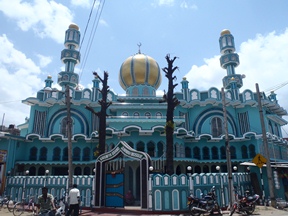
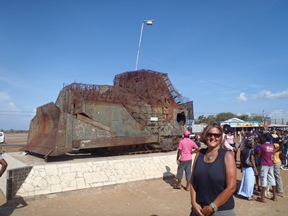
Just prior to us setting off it was ruled that travellers north no longer needed an MOD pass. This is a big step forward making it easier to travel north and a sign that the troubles are finally over. It would be naïve however to say that all the troubles are past -we heard whisperings which implied that a lot of Tamils are still angry - and then there was the now infamous Channel 4 doco which sent the Government controlled press here into a defensive spin. Anyway, thankfully now it's so much easier to come up north more and more international and domestic tourists will visit this fascinating area.
Anyway as above there is now only one police block on the road through the Vanni -just north of Vavuniya and it was a routine matter of getting the passports' details entered in a log before we were "on the road" again. We stopped briefly at the nearby "Elephant pass" an army base with both a newly opened memorial to peace and a reminder of the war, a bulldozer which had been used by a "Black Tiger" (a suicide bomber for the Tamil Tigers) for a suicide attack on the army base here. The young SLA soldier who had thrown himself on the vehicle thus blowing it up early and saving his colleagues was commemorated on a plague. Very sad.
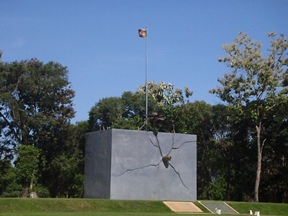

Near Kilinochchi a town which was the Tigers' HQ when they controlled this area, we stopped to look at both another memorial celebrating the end of the war as well as a huge water tank which had been blown up (by the Tigers) and which is now a somewhat bizarre tourist attraction with ice cream and t-shirts for sale! Seems a silly thing to have done -water is so precious here - but I guess that's war for you!
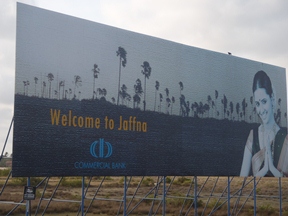
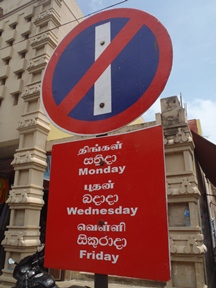
The road going on was a bit corrugated and bumpy (we were airborne a couple of times!) but ok for all that and we got to Jaffna by late afternoon. It was just as well we had a bit of light as we had a bit of a struggle finding somewhere to park.
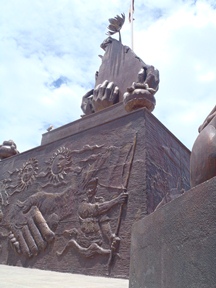
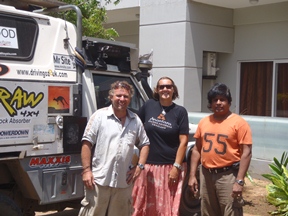
We've been really lucky thus far in Sri Lanka - rarely having to pay for a camping spot and never being knocked back but at first we didn't do so well at Jaffna. Firstly as it was pretty hot and humid this far north we decided to try the beachfront. This was still heavily full of the military and until recently much of it had had security check points -which even local fishermen had to go in and out of every day - so maybe for this reason all the guesthouses once here seemed to have gone to the wall. A few small guesthouses specializing in providing accommodation to NGOs seemed welcoming, and probably would have let us camp but they didn't really have enough room for us to unfurl the shower tent and get comfortable! A couple of the bigger hotels said no, I think they really just didn't get what we meant -I guess not very used to tourists. We asked some of the numerous army/police but their English wasn't too good here and we had difficulty getting across what we wanted. We asked at the city centre Tilko Jaffna City Hotel who said yes -but that we had to either pay 2,500 LKR or spend 5,000 a day on food in their restaurant so we decided not to bother as this was out of our price range.
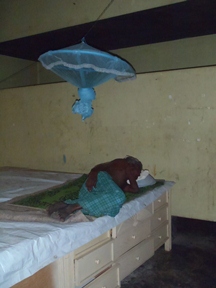
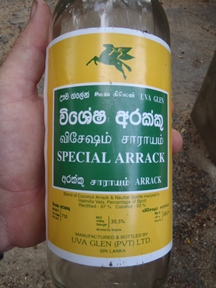
We were just leaving when the guys working at the factory next door (drying sea cucumbers - lucratively exported to Japan apparently) came over for a chat so we stopped for a while. This turned out to be extremely fortuitous as the owner of the Tilko Jaffna City Hotel had come in pursuit of us. Thilka, a Jaffna born Tamil businessman fled SL in the 1980s -as did so many Tamils - after the riots and now lives in the UK. He had obviously made very good in his adopted home, owning hotels and running a business in London as well as owning a lot of properties in SL. He suggested that we camp at an old house he had bought in the city, planning to later develop it into budget accommodation.


So finally we found a good safe place to base ourselves whilst in Jaffna which was great. We also ate at the Jaffna City Hotel and used their Wi-Fi many times -thanks to Thilka and his staff for their kindness and hospitality.


At the house we even got our own in house security guard. Vincent was a bit of an experience. The first night we met him and he showed us where to lock the gate etc etc turned out to be the only time in the 5 days we were there that we saw him anywhere near sober! We're not sure if we just caught him on a very rare day -or if he was led astray by some friends who came to stay for the big Hindu festival but every time we saw him he was absolutely pie eyed! That "Special" Arrack has a lot to answer for!
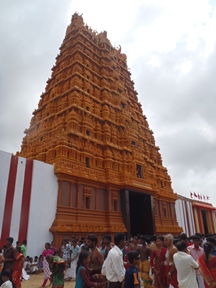

Anyway -we slept well after our long drive and next morning headed just up the road to the nearby Hindu temple -the Nallur Kandaswamy Kovil. When reading the LP about going to Jaffna we'd come across a big festival held here over the month of August which climaxed on the penultimate day with a massive parade of juggernauts and self-piercings by devotees. Good on the Lonely Planet -some people malign it but otherwise we'd never have known about this festival -perhaps the reason why we were almost the only international (non SL) tourists there. We asked about it at the tourist office in Colombo but no one had a clue. They need to update their info on Jaffna now the war is over.
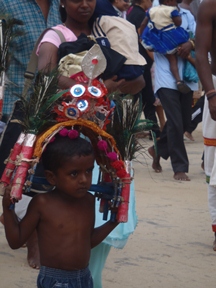
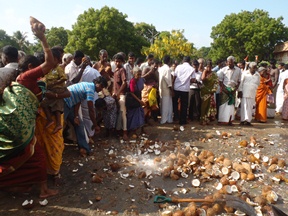
This was the day before the "big day" but the action was already ramping up. The ladies looked gorgeous donning their best saris and all their best gold no doubt. The temple is a pretty impressive building, the most significant Hindu place of homage in SL. Dedicated to the god Murugan, Ganesh's brother the current building dates from 1734 as the original 15th century one was destroyed by the Portuguese in a fervor of Catholicism. No shoes, shirts (for the men) or cameras inside the temple confines so you'll have to believe us it was impressive - a huge central water tank and numerous statues of the deities.
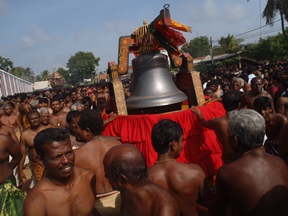

The big climax of the festival is when the Car (or chariot for the gods) is pulled out of its garage and pulled by teams of devotees around the complex. The Car itself was amazing -teams of devotees had worked on it for days -polishing up the brass work and intricate carving until it shone, it was a truly awesome sight. In the morning the Car is pulled around the temple and then back into place for another year before a heaving crowd. It was pretty intense - over 100,000 people - and it was almost a bit scary as the huge crowd had to be pushed back to give the Car a turning circle.
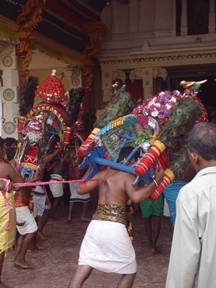
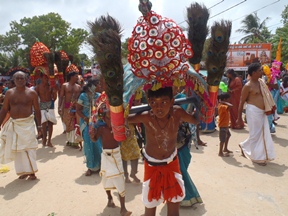
Talking of intense - OMG then the piercings started! We had seen a similar festival when we first ever hit Malaysia and at the beginning when we saw the dancers of all ages, some with fish hooks through their backs we thought, "Well, we've seen all this before anyway." Then we saw the flying piercers!
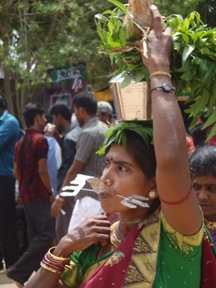
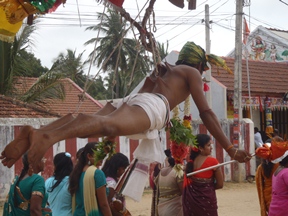
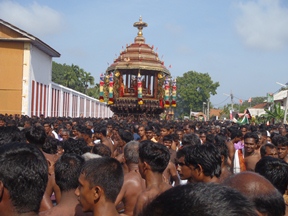
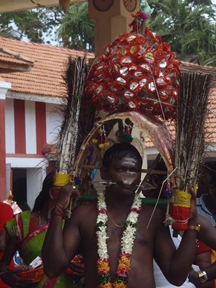

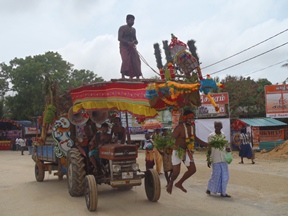
These guys come from their various temples from surrounding villages hung from decorated tractors by huge fish hooks -piercing their shoulders, backs and legs. We actually happened upon a pair being "set up" at a small temple out of town and heard a bit more about it. Apparently it is done to atone for sins and the devotees fast for 6 days and pray to get themselves in the right head space before being "fish hooked." We had to look away but I have to say neither of them flinched when the hooks went in. Also amazingly no blood.

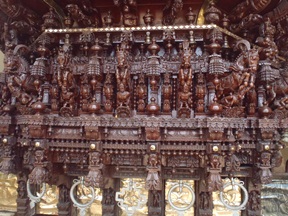
So, these 2 joined the throngs of other tractors to be pulled up and down by "drivers" on the tractors' roofs as they circumnavigate the temple. In additional circling the temple are assorted groups of dancers, (pierced and unpierced) and rollers. These latter roll around the temple as a way of (again) atoning for sins, some in large groups and you have to keep an eye out for them as they're a bit lethal and I nearly got knocked off my feet by a long line! There was an area where coconuts were loudly smashed - as a blessing - and the "hangers" often smashed them down as they made their painful way around the circuit.

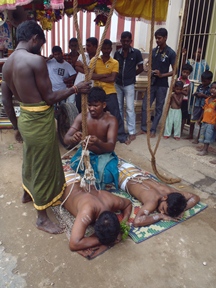
What with the heat and the drums the whole thing was a bit exhausting and we had to retire 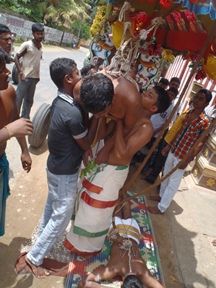
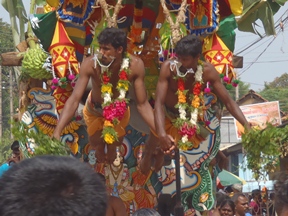
after a few hours each day. Full on!
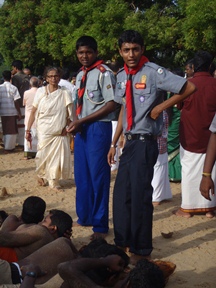

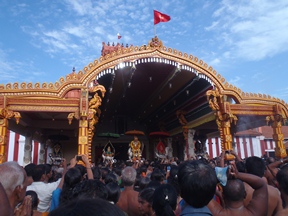

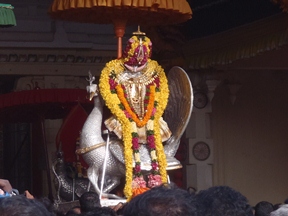

The next morning we saw the gods (the main one his 2 wives, his brother and one more we never nailed down who!) on their silver vehicles (peacocks and rats) again being carried around the temple following a bath in the Centre tank. We ventured into the tank area which was a bit rash. As the only foreigners we were marked men and got quickly soaked in holy water -so thoroughly that we had to go back to change. Means we're blessed apparently!!!
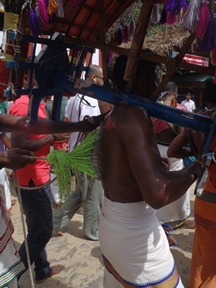
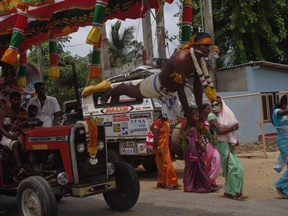
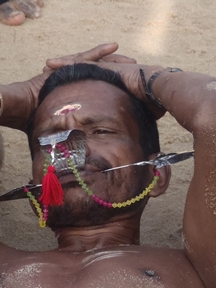

There were teams of Red Cross volunteers and Scouts on hand as well as a heavy police presence - though there was no trouble -and somewhat amazingly no casualties other than a few overzealous devotees being doused down with water. Words really don't describe this festival, it was absolutely amazing -definitely one to try and see- we were so glad we'd managed to coordinate our trip north with this -incredible!

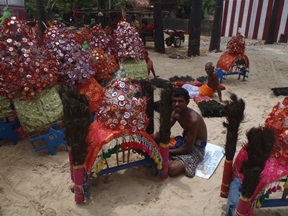
When we were recovering from the temple crazy goings on we got to see a bit of Jaffna. A great spot- very like India but in a toned down way.
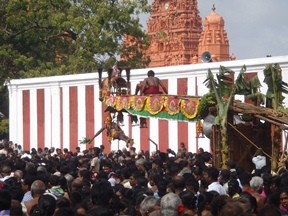
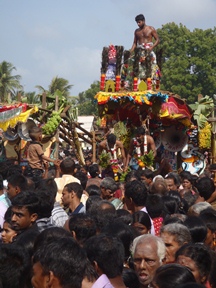

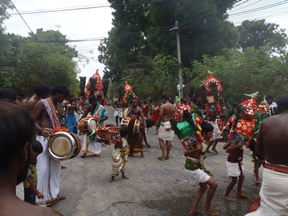
The tropical heat and greenery and friendly smiley Tamil people gave a really relaxed vibe as did the colonial architecture and the lovely old fashioned cars now used as taxis. However the bullet holes, razor wire destroyed buildings and army presence reminded you that not long ago this was a full on war zone. The Tamils here the "Jaffna Tamils" are a distinct separate group from the "Plantation Tamils" brought here by the British in the 19th century to work on the tea plantations. The Jaffna lot are a highly educated race, who've lived in SL since crossing from South India in the 4th century BC. Being quicker to learn English (still seems to be true) they were favoured by the British so that they came to dominate Government and other professional jobs despite being a minority. This caused resentment leading to the "Singhalese only" language policy and dreadful riots in the 1950s and the 1980s when the Tamils were literally slaughtered. Thousands of Tamils fled to Europe, Australia, Canada and America where they seem to have thrived judging from the ones we met from all over the world (lawyers, engneers, doctors, university professors) who had returned for the festival.
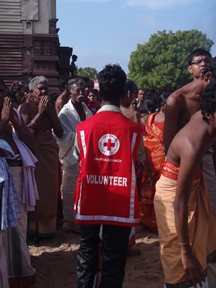
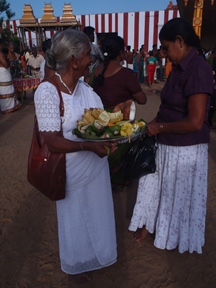
A separatist movement formed in the 1970s the LTTE or the Liberation Tigers of Tamil of Eelam (Eelam means precious land in Tamil) aka the Tamil Tigers set out to fight for the Tamils and found their own separate state. After the riots of the 80s many of the Tamils in exile and sympathy groups in India assisted funding the Tigers. That's the history of the conflict in a nut shell -my view only obviously. Now thankfully the war is over though some legitimate areas of conflict still exist. It's hard as an outsider to get a real handle on it -we did speak to some Tamils up north who were still very angry at the Government but most of the people both Singhalese and Tamil were very keen to live in peace -and thankful that the years of conflict were ended.
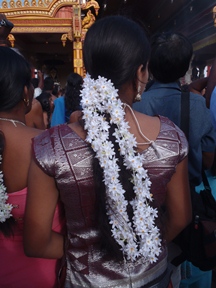


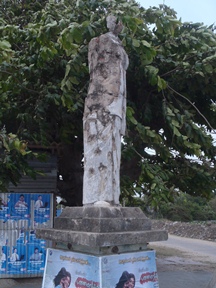
We met a great many "Southern" Sri Lankans in Jaffna who were visiting for the first time which was good. Hopefully the more they come it'll lead to an increase a) money into the area and b) understanding between the 2 groups.
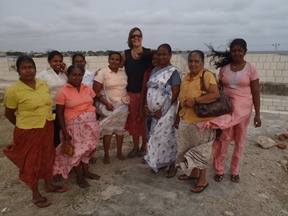
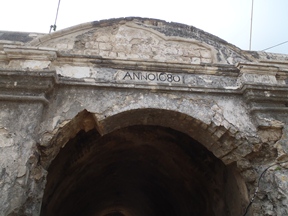
We had a look around the old fort initially Portuguese then Dutch it saw some action in more recent times when the LTTE forced out government troops after a 3 month siege in 1990, but it's now open to the public. Work has begun (with the help of the Dutch government) to rebuild it. A big job ahead -which seems it be employing a lot of locals which is all to the good.

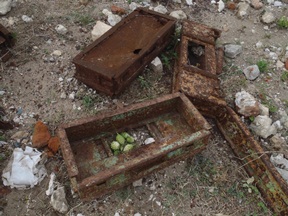
We hit the Malayam Café a couple of times -a heads up from our friend Tim who comes here a bit on business. A great spot with great South India treats and a good vibe -all wooden floors and high slowly rotating ceiling fan. The Jaffna food is great -really hot -which us how I like it!

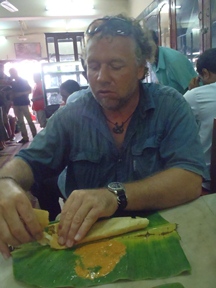
One place we wanted a look at was the library. This was a) shut Monday and b) only opens to observers as opposed to "proper' library users for an hour or so a day, so it took a few goes before we actually caught it both open and attainable but it was worth it in the end.
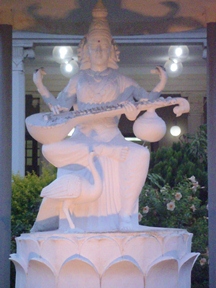
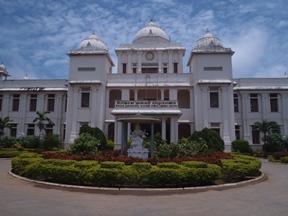
An impressive colonial style building fronted appropriately enough by a statue of Saraswathi the Hindu Goddess of education this building was a rebuild of the original 19th century one which was completely gutted by an angry pro-Government mob in 1981-an act which really helped fire up the conflict which followed. Books were donated from around the world to replace some of the 90,000 (some irreplaceable) ones lost. Whilst a plaque commemorates the re-opening little is made of how the earlier library came to be lost in contrast to the blown up water tower at Kilinochchi (see above) which is made much of as an act of terrorism.
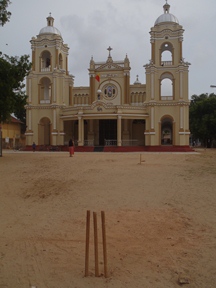

Though the LTTE did drive out the Muslims when they were in power, thankfully Muslims Christians and Tamils now seem to live together happily here. There were quite a few grandiose Christian churches -Vincent our guard was a devout catholic who would yell the praises of Mother Theresa -sometimes long into the night! Anyway we did visit one church - St James - with a full on cricket match going on out front. It had actually been bombed in the hostilities - but we couldn't work out who by -or how old it was. Few tourist signs in this area so unless you happen upon an English speaker you're a bit in the dark!
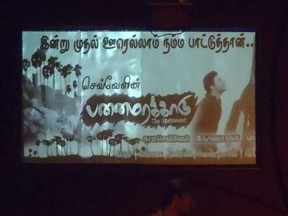
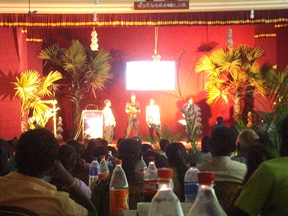
Finally before we left Jaffna we were invited to a Tamil film awards ceremony by a lady we'd met as she was staying at the Jaffna City Hotel, who was the recipient of one of the awards, best artistic director I think. Much of it was in Tamil so we were a bit lost but a visiting Indian guy from the Tollywood film industry of Tamil films based in Chennai spoke in English which was interesting. Apparently Indian Tamil actors are banned from working in SL due to the known support of the Tigers from within the industry. A famous Tamil actor MGR (MG Ramachandran) actually donated $4 Million USD to the cause in the late 80s!! According to our LP there was a statue of him in town but perhaps unsurprisingly we found no trace of it!! For more about the Tamil film industry see their site www.aaamovies.info
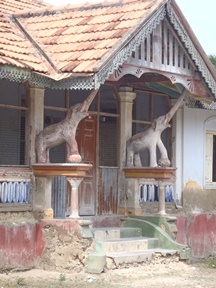
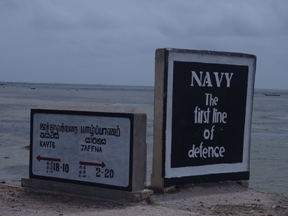
Other than Jaffna we explored further afield into the northern peninsula. Once you leave the city behind you're very quickly in the middle of lush green vegetation. Bruised and battered from the long conflict there is a poignant beauty here -lots of old colonial mansions which had definitely seen better days, and many vibrant Hindu temple -some badly damaged many already repaired and back in good order. There was an interesting looking fort -dating from the Dutch era - but it was occupied by the military and so strictly off limits.
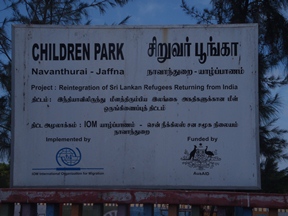
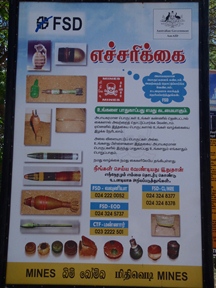
What with the tsunami, flooding and war this area definitely needs a bit of a helping hand and we were really pleased to see when driving around that Australia was doing its bit - having projects involved in a number of different initiatives from building houses and kids' playgrounds to assisting with de-mining. Some of the areas to the north particular are still heavily mined and there are numerous organizations training locals to help in the dangerous work of de-mining - such as MAG the UK based organization which we saw a lot of in Cambodia and Laos. Thankfully the problem's nowhere near as bad as there but we did still see a few guys with missing limbs due to these awful devices. De-mining NGOs employ around 3,000 locals to assist with this work. Also like Cambodia malaria/dengue is still a problem up here- a bad reminder of Andrew's experiences there-and we saw many warning posters. Time to pull down the mozzie nets - sadly you can't buy good spray cans of DEET based repellant here. I really miss that! I know it's not great for you, but if you're a mozzie magnet like me it's the only thing that seems to work!
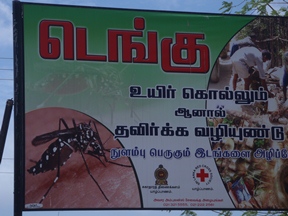
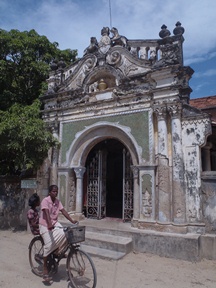
Driving out along the causeways to the beaches we saw more aid work this time from the Japanese. The organization PARCIC had set up fish drying plants, where fish is cut up and dried by local ladies prior to being sold throughout Sri Lanka. The ladies were really pleased to have work and it's a step in the right direction bringing money into these areas - see more about this project on their site www.parcic.org/english
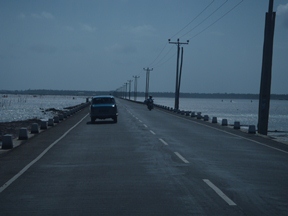

Just within striking distance there are some lovely beaches like Casuarina Beach -once off limits to all but navy personnel now you are allowed there. There's still a really heavy military presence and a few road blocks to go through.

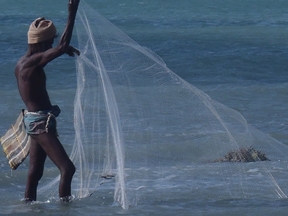
We walked up the beach and chatted to the local fishermen. Life is getting much better for them - now that the hostilities are over they can sell their fish /crabs /prawns down south and what with that and the new PARCIC project as above -things are better for them than for a long time which was great to hear. Andrew's just posing with that fish by the way ..he didn't catch it!

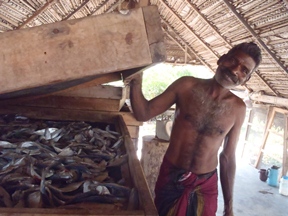
We went to a little bar/café which turned out to be the navy out post and asked permission up the chain of command to stay there the night -which was very kindly granted. So, we had our own private beach for a late night swim once the crowds had gone, as well as a navy cooked supper of fried rice. Thanks for letting us stay guys. This area as a whole unsurprisingly has much less in the way of tourist infrastructure than elsewhere in SL so we have to be a bit creative finding places to stay once more -no resorts to ask out here!
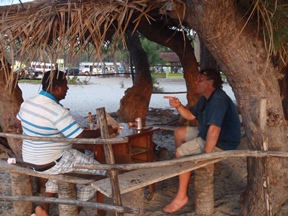

So -we woke up on the beach surrounded lowing by cows. Incidentally we've noticed on our travels that whilst the cows tend to look healthier than those in India (less of a rubbish based diet maybe) their brandings are terribly brutal -it often looks like they've been hacked about with knives -surely unnecessarily cruel - not very Buddhist.

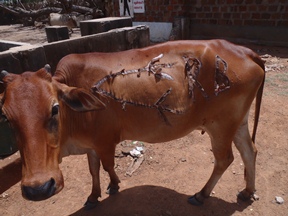
You've got to take a boat trip on holiday and we headed out to one of the remote outlying islands, Nainativu. We had wanted to go to Delft the furthest flunk island which has a population of wild ponies bred from the ones the Dutch brought over. I really wanted to see this but we got bad information and so missed the one ferry a day which goes there and we were running out of days.

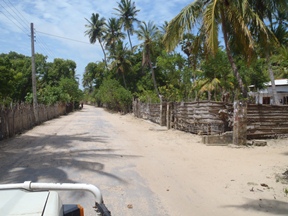
Nainativu was far closer and more accessible so we joined the long queues and loaded onto a little boat. I was really pleased we were last on so could sit up top as I don't like boats very much and would have hated being packed down below the deck. I felt a bit queasy after just the 17 minutes across so maybe it was just as well we missed the Delft boat as it's a lot further!

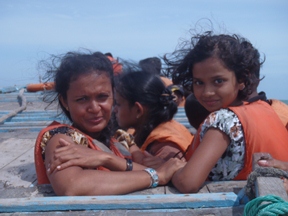
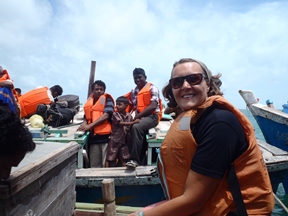
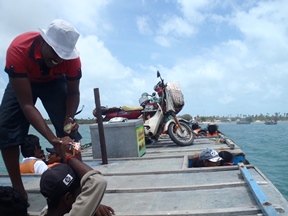
This little island is a place of pilgrimage for both Hindus and Buddhists. There are very few sacred Buddhist sites in this region but the Naga people who live here were said to have been converted en-masse after a visit from the Buddha.
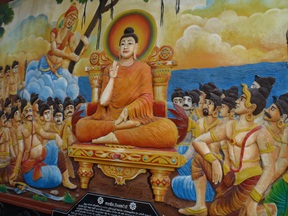

I was confused about this as I'd understand that whilst Buddhism spread here to be the majority religion the Buddha never set foot here. "That's true" a passerby told me "he came by air" (Lanka Air??) -allegedly he hovered over the island, resolving a dispute between a chief and his nephew and thus preventing a war and converting all the Nagas on the spot! The Nagadipa temple stands here as a reminder of this, as well as a sacred Bodhi tree and a few statues.
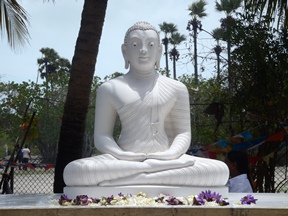

Apparently up to a short while ago there was a check point between the 2 temples (the Hindu one Naga Pooshani Amman Kovil is just 10 minutes' walk away) but that's now gone, you just walk past umpteen stalls selling jaggery sugar, artifacts and local dried tobacco.

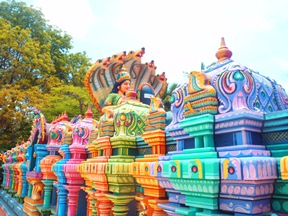
The Hindu temple is very psyadelically coloured as they tend to be! The temple is dedicated to the goddess Meenakshi and ladies seeking to conceive come here for a blessing. Perhaps as we visited just after the big Hindu festival there were throngs of devotees here.
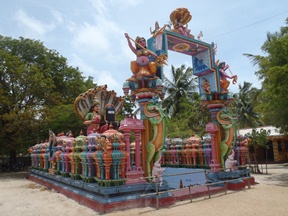

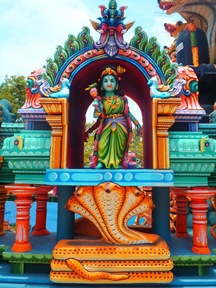

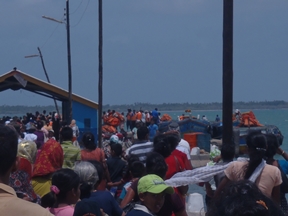
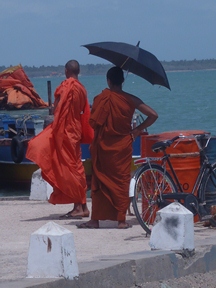

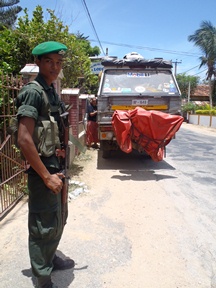
Finally before heading South from Jaffna we headed up to Point Pedro so we could say we'd visited the northernmost point of the island. On the way we stopped off in Nelliady to see the site where "Captain Miller" a Tamil Tiger commander drove an explosive laden truck into the local school -which was being used as an army station. He died taking 200 SLA personnel with him. Like always in these matters this makes him alternatively a hero or a terrorist depending which side of the fence you're on! The girders from the building -totally contorted by the blast - now form the edges of a decorative garden in the school grounds. According to our LP a statue of Captain Miller stands here, which unsurprisingly we couldn't find. There was a statue in front of the school -wrapped up in a sheet but no one could understand us (or pretended they couldn't!) when we asked if it was him.

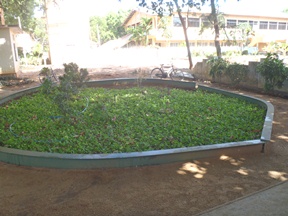
There was still a sizeable army presence in this far north area and the beach area around Port Pedro and its lighthouse is still occupied by the military though you can come and go through it and we weren't stopped at all. Thilka the proprietor of the Jaffna City Hotel owns a house right on the beach here. He has plans to develop it into a hotel but it is empty at present and he very kindly said we could camp there.

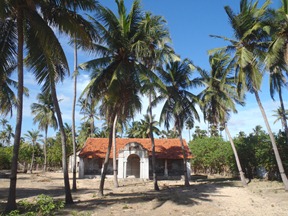
We actually found it from the small hand drawn map provided very quickly but then had an hour's wild goose chase driving around in circles! "Horton's House" was named after the former English owner but unfortunately no one knew it by that name, and maybe as they thought we were looking for a "proper" hotel it took a while to find it and establish that we'd been in the right place initially!

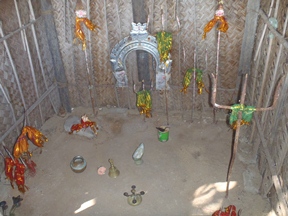
We couldn't actually drive in as there was only a narrow (Shell!) gate and an army post blocking the main way in, but never mind -the fisher people (another PARCIC project) made us very welcome and invited us to camp on the beach front next to a large Bodhi tree with an improvised Shiva temple built out of tin just next to it.

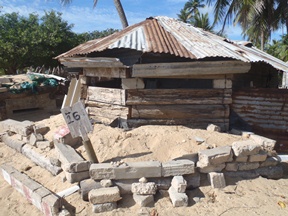
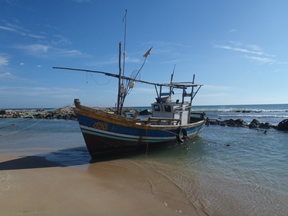

The early morning fishermen woke us by ringing the temple bell before they went out, presumably to seek blessings whilst out on the treacherous ocean. Once more we were well away from tourist territory here -but we found the one "restaurant" in town -a little shack selling kotthu rotti -a sort of pancake chopped up and stir fired with chilly and chicken -and it was very nice.
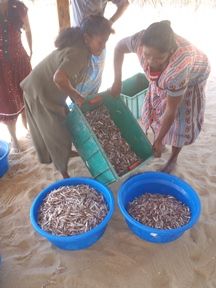

We walked back up the beach and saw an awesome sunset -beautiful spot. Thilka has plans to develop Horton's house into a colonial style bungalow /hotel -we'll have to come back one day to provide "Before and After" photos!


We had been worried as prior to going to bed no one had arrived at the soldiers' post so we hadn't been able to explain ourselves- and we were concerned that the returning soldiers would wake us up in a panic at some ungodly hour -but thankfully that didn't happen -so it seems that the post is now not manned. Andrew went to have a look inside and was horrified that a few boxes of live ammunition were left lying around -where kids or anyone could get to them. Not good! We'll let the tourist authorities know.
 So -we began the trip south and then east across to Mannar the eastmost point of the island. On the way out we took a detour to see Our Lady of Madhu Church an important Christian shrine. The small Madonna and child statue was brought here by fleeing Catholics who had been first converted by the Portuguese and were now a century or so later escaping Protestant Dutch persecution! The statue remains here to this day where it attracts hordes of pilgrims -being seen as offering protection from snake bites. For some reason we took no pictures here -it was an attractive enough church but the stars of the show for us were the bell ringer and his assistant. An old man, he walked up to ring the bell for mass and his dog trotted up and stood by him howling throughout and then sat back down. Apparently he accompanies the bells several times a day!
So -we began the trip south and then east across to Mannar the eastmost point of the island. On the way out we took a detour to see Our Lady of Madhu Church an important Christian shrine. The small Madonna and child statue was brought here by fleeing Catholics who had been first converted by the Portuguese and were now a century or so later escaping Protestant Dutch persecution! The statue remains here to this day where it attracts hordes of pilgrims -being seen as offering protection from snake bites. For some reason we took no pictures here -it was an attractive enough church but the stars of the show for us were the bell ringer and his assistant. An old man, he walked up to ring the bell for mass and his dog trotted up and stood by him howling throughout and then sat back down. Apparently he accompanies the bells several times a day!
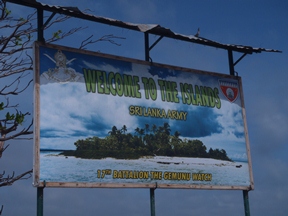
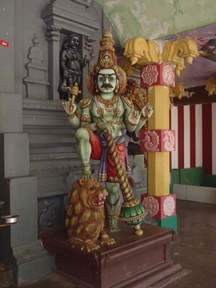
The drive out east is through some of the most heavily mined areas in the country and we saw a few teams at work de-mining. There are quite a few refugees living in this area in makeshift camps all waiting for their land to be cleared so they can get back to farming it.

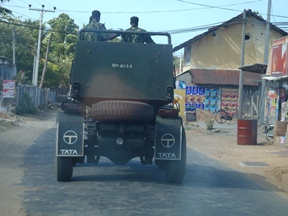
We drove across the bridge to the town of Mannar and 30km on through the narrow peninsula which was home to numerous wild donkeys, to reach Talaimannar. This small fishing settlement, with a few Muslim families and the navy the only residents is as near as you can get to Adam's Bridge the crossing from Rameswaram in India.
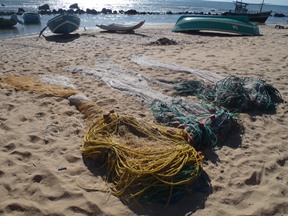

We had been really keen to drive to the start of the bridge in SL as we had visited this area when we were first in India-driving right to the point where the "bridge" a series of stones which feature in Hindu legends - began. Sadly this was now all navy controlled so we couldn't access it. There was though a sign saying boat trips to the bridge were possible. So -we decided to wait and go the next day- thus we had to find somewhere to stay the night. The navy agreed we could camp there and one of the fisher families arranged to cook us a meal. The fish curry was VERY salty and a bit gritty but we made a good attempt -especially as the whole village came out to watch us eat! Like Bangladesh again!

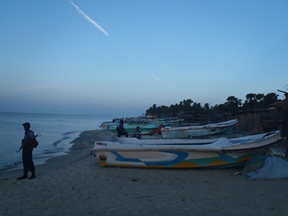
The navy woke us up at 4am going on an armed search of the fishing boats as they went out. Apparently looking for "heroins" or other smuggled goods one of them told us! It reminded us that when we were in SE India just across the water some shadowy figure had tried to sell us what they claimed to be Sri Lankan gems smuggled over by boat, though thankfully we were never offered heroin!
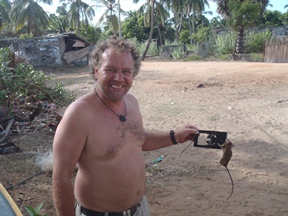
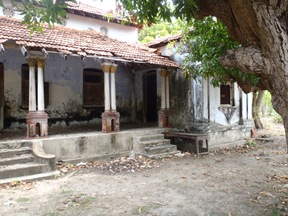
Next morning when we awoke there was a bit of sad news -we finally lost the hitch hiker we had picked up in Kandy! Since leaving Kandy we'd noticed that Andrew's cushion was being slowly emptied and that any bananas left in the front cabin overnight were liable to be nibbled. Ratty (he'd got a name by now) had managed to evade our trap so far -but he came unstuck that night and his broken body greeted us that morning! We actually felt a bit sad as whilst he'd had to go as he had now progressed to eating our wiring, we'd hoped to just catch him and let him go in a peaceful manner. He was (we think) living in the air duct of the car ventilation system- we have yet to investigate. He was pretty big- I'd imagined a little mouse like creature!
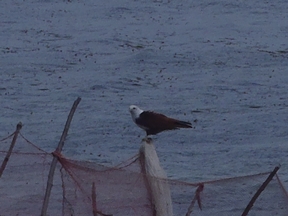

Sadly we never made it onto the boat to Adam's Bridge! We managed to satisfy points 1 and 2 of the rules -being sober and over 3 feet but we couldn't nail a ticket! We went and waited with the Sri Lankans who were all paying 500 rupees a ticket. They all left and the navy guy made us wait around another hour and then came out and said we couldn't have tickets but we had to pay 3,000 rupees each for our trip! No doubt destined for his back pocket. We're not tolerant of this crap so we told him where to stick his boat trip. A real shame as we'd like to have seen Adam's Bridge from both sides but we'd wasted enough time as we had quite a way to drive.
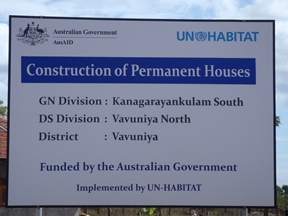
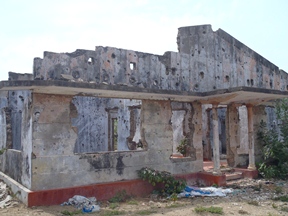
So we said goodbye to our nice fisher family and drove back to Mannar town. We had a quick look at the ruined Portuguese /Dutch fort -formerly controlled by the military you can now enter the grounds and look at the ruins and donkeys. Maybe one day they'll look into restoring this one like they are in Jaffna -an even bigger job!

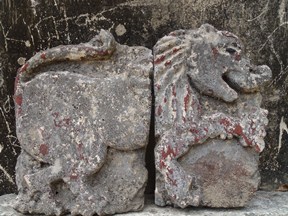
Mannar's only other attraction is an ancient (1477) baobab tree, allegedly planted by the earliest Arab traders the forebears of SL's Muslim population. It was pretty impressive measuring 19 metres in circumference.

So, we left the north heading east back towards the coast. On the way we passed a very scenic "Giant Tank" as the map described it -alive with bird life. It was an easy journey and by midafternoon on Friday 2 September 2011 we once more hit the coast at Trincomalee and headed further north to the beautiful beach of Nilaveli and more particularly the luxurious Pigeon Island resort.

